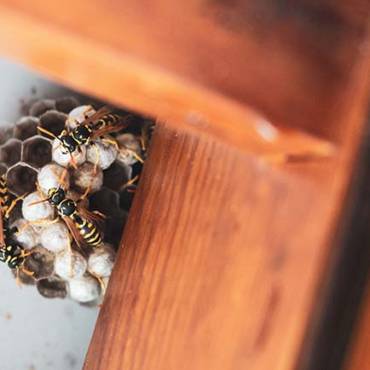Protecting Your Home from Carpenter Ant Damage: Expert Advice from Bee Smart Pest Control
Carpenter ants are a common concern for homeowners across the country, particularly in Thornton, CO, and the surrounding areas. These destructive pests can cause extensive damage to your home’s wooden structures, compromising its stability and value. It is crucial to recognize the signs of a carpenter ant infestation, understand their behavior and preferences, and implement effective prevention and control measures.
Carpenter ants are large ants, typically black or reddish-brown, and are often misidentified as termites due to their similar habits of burrowing through or nesting in wood. Unlike termites, carpenter ants do not consume the wood; they simply excavate it to create nests and tunnels for their colonies. As a homeowner, it is essential to understand the signs of a carpenter ant infestation and the specific strategies required to manage these insects effectively. Ignoring the signs or employing ineffective treatment methods can lead to costly repairs and potentially irreversible damage to your property.
In this comprehensive article, we will explore the habits and preferences of carpenter ants, the damage they can inflict on your home, and the importance of enlisting the help of a professional pest control service like Bee Smart Pest Control for effective prevention and management.
1. Understanding Carpenter Ant Behavior and Preferences
To effectively prevent and address carpenter ant infestations, it is crucial to understand their habits and preferences:
- Nesting Sites: Carpenter ants are drawn to moist or damaged wood, such as rotting tree stumps, damp logs, or wooden structures affected by water damage.
- Diet: Unlike termites, carpenter ants do not consume wood. Instead, they typically feed on dead insects, honeydew from aphids, and plant juices.
- Colony Expansion: Carpenter ants build satellite nests in nearby suitable locations as the colony grows, increasing the potential for structural damage.
2. Signs of Carpenter Ant Infestations
Recognizing the signs of a carpenter ant infestation is key to addressing the problem before it causes significant harm:
- Wood Shavings: Piles of wood shavings or “frass” are indicative of carpenter ants burrowing through wood to create tunnels and nests.
- Winged Ants: Carpenter ants produce winged reproductive members called swarmers. The presence of swarmers inside your home or nearby can signal the existence of a colony.
- Squeaking or Rustling Noises: Sounds of ants gnawing on wood or moving through tunnels may be heard within walls, floors, and ceilings.
- Trails of Ants: Spotting carpenter ants moving back and forth within your home or property suggests that they are actively nesting or searching for food.
3. Preventive Measures for Carpenter Ant Infestations
Implementing effective prevention strategies can help protect your home from carpenter ant invasions and the damage they cause:
- Repair Damaged Wood: Replace or repair rotting or water-damaged wood in your home, reducing the likelihood of carpenter ants finding suitable nesting sites.
- Eliminate Moisture Sources: Repair leaks, ensure proper ventilation, and maintain gutters and downspouts to keep wooden structures dry and unattractive to carpenter ants.
- Remove Yard Debris: Dispose of rotting tree limbs, logs, and other wooden debris around your property to reduce potential nesting sites.
- Store Firewood Properly: Stack firewood off the ground and away from your home to prevent ants from infiltrating your house via the woodpiles.
4. Addressing Carpenter Ant Infestations
If you suspect a carpenter ant infestation, take the following steps to ensure the safety of your property and prevent further damage:
- Inspection: Conduct a thorough inspection of your home and property to identify areas of infestation, paying particular attention to damp or damaged wooden structures.
- Consult a Professional: Contact a professional pest control service, such as Bee Smart Pest Control, to provide an expert assessment and create a targeted treatment plan.
- Prompt Treatment: It is crucial to address carpenter ant infestations as soon as they are detected to minimize the extent of the damage and prevent costly repairs.
5. The Importance of Professional Pest Control Services
Engaging the services of a professional pest control company like Bee Smart Pest Control is vital for effectively addressing carpenter ant infestations:
- Expert Knowledge: Pest control professionals have the experience and knowledge required to identify carpenter ant issues and recommend the most effective treatment options.
- Comprehensive Solutions: Professional pest management services address not only the immediate carpenter ant problem, but also look for underlying issues, such as moisture sources, that may contribute to infestations.
- Ongoing Support: A professional pest control service can provide ongoing support and monitoring to ensure that carpenter ants do not return, keeping your home secure and free from these destructive pests.
Conclusion
Managing carpenter ant infestations requires an understanding of the pests’ behavior, preferences, and potential impacts on your home, as well as targeted strategies designed to prevent and address these issues. With the support and expertise of professionals like Bee Smart Pest Control, you can confidently face the challenges posed by these destructive pests and maintain a secure, damage-free home for years to come.
Bee Smart Pest Control offers expert advice and house ant control to protect your home against carpenter ant damage, ensuring a safe and comfortable living environment for you and your family. Trust in our expertise to guide you toward effective, targeted solutions that protect your home from these destructive pests, ensuring a safe and damage-free living environment for you and your loved ones. Contact us today to schedule a consultation!




